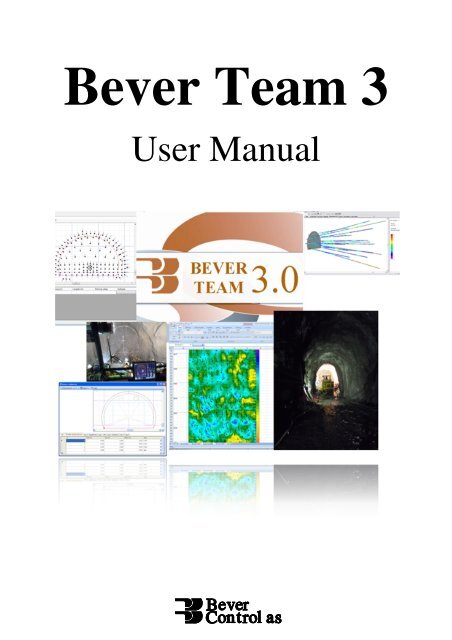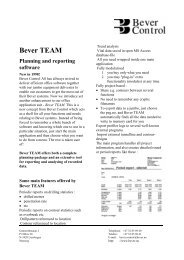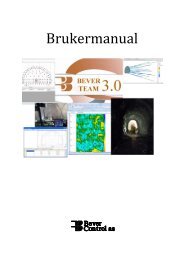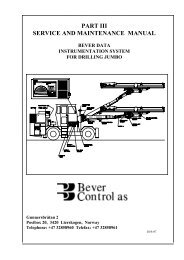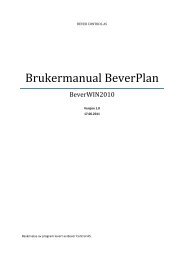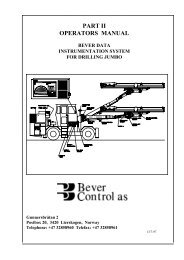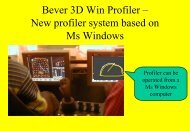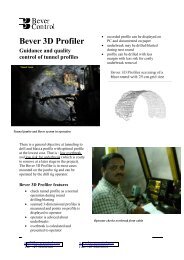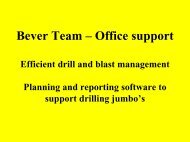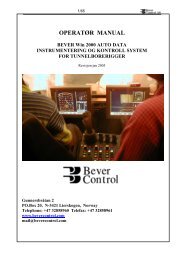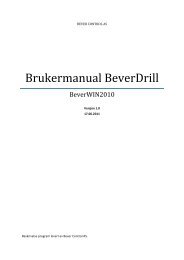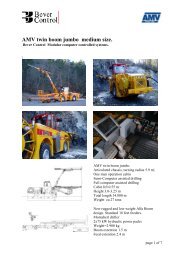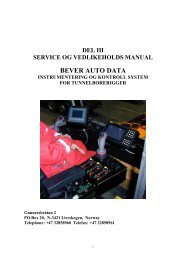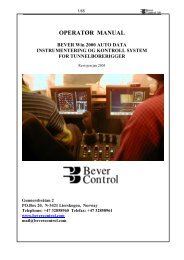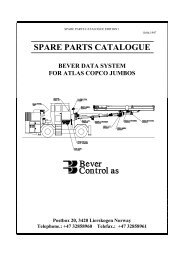User Manual - Bever Control AS
User Manual - Bever Control AS
User Manual - Bever Control AS
You also want an ePaper? Increase the reach of your titles
YUMPU automatically turns print PDFs into web optimized ePapers that Google loves.
<strong>Bever</strong> Team 3<strong>User</strong> <strong>Manual</strong>
<strong>Bever</strong> Team 3<strong>Bever</strong> Team 3Operators <strong>Manual</strong>© Copyright 2009-2010 <strong>Bever</strong> <strong>Control</strong> <strong>AS</strong>. All rights reservedThis document is being furnished by <strong>Bever</strong> <strong>Control</strong> <strong>AS</strong> for information purposes only to licensed users of the<strong>Bever</strong> Team product and is furnished on an “<strong>AS</strong> IS” basis, that is, without any warranties, whatsoever, expressedor implied.<strong>Bever</strong> Team ® is service mark and registered trademark of <strong>Bever</strong> <strong>Control</strong> <strong>AS</strong>.Other brand and product names are trademarks or registered trademarks of the respective holders. Microsoft is aregistered trademark and Windows, Windows XP, Windows Vista, Windows 7, the Windows logo, and theWindows XP/Vista/7 logo are registered trademarks of the Microsoft Corporation. Acrobat Reader and theAcrobat logo are registered trademarks of Adobe Systems Incorporated.Information in this document is subject to change without notice and does not represent a commitment on thepart of <strong>Bever</strong> <strong>Control</strong> <strong>AS</strong>. The software described in this document is furnished under a license agreement. Thesoftware may be used only in accordance with the terms of that license agreement. It is against the law to copyor use the software except as specifically allowed in the license. No part of this document may be reproduced orretransmitted in any form or by any means, whether electronically or mechanically, including, but not limited tothe way of: photocopying, recording, or information recording and retrieval systems, without the writtenpermission of <strong>Bever</strong> <strong>Control</strong> <strong>AS</strong>.<strong>Bever</strong> Team 3Operators <strong>Manual</strong>Written by Karsten HaukaasInitial publishing in Norwegian May 2009Updated October 2010Document No. BT3-1 Revision BPrinted in NorwayAddress: Telephone: Telefax: E-mail: Web-address:<strong>Bever</strong> <strong>Control</strong> <strong>AS</strong> +47 32 85 89 60 +47 32 85 89 61 mail@bevercontrol.com http://www.bevercontrol.com/Gunnersbraatan 2P.O. Box 20N-3421 LierskogenNORWAYPage 2
<strong>Bever</strong> Team 3Content1 What is <strong>Bever</strong> Team .......................................................................................................72 Definitions ......................................................................................................................73 Installation ......................................................................................................................73.1 Installation with XP OS and service pack 3 .............................................................73.2 Licensing ................................................................................................................84 Main screen ....................................................................................................................95 Make a new project .........................................................................................................95.1 Advanced connection ............................................................................................ 121 The Menu ..................................................................................................................... 161.1 Submit to database ................................................................................................ 171.2 Open ..................................................................................................................... 171.3 Save ...................................................................................................................... 171.4 Geometry .............................................................................................................. 171.5 Settings ................................................................................................................. 171.5.1 Jumbo Configurations ....................................................................................... 181.5.2 Point types: Design ........................................................................................... 181.5.3 Contour Layers .................................................................................................. 191.5.4 Auto drill plans for Win2000 jumbos ................................................................ 191.5.5 Report: Contour surface .................................................................................... 191.6 Virtual Earth ......................................................................................................... 201.7 Help ...................................................................................................................... 202 The Screen .................................................................................................................... 213 A geometric minimum – how to create a quick tunnel ................................................... 224 Sheets - overview .......................................................................................................... 245 Sheet - Tunnels ............................................................................................................. 255.1 The columns ......................................................................................................... 256 Sheet - Line .................................................................................................................. 257 Sheet - Horizontal ......................................................................................................... 268 Sheet - Vertical ............................................................................................................. 279 Sheet - Camber ............................................................................................................. 2710 Sheet - VIPS ................................................................................................................. 2711 Sheet - Changes ............................................................................................................ 2812 Sheet - Contour ............................................................................................................. 281 Overview Production Planning...................................................................................... 311.1 Face ...................................................................................................................... 311.2 Laser ..................................................................................................................... 321.3 Point ..................................................................................................................... 321.4 Drill Plan .............................................................................................................. 341 Drill plan ...................................................................................................................... 361.1 Create helper lines ................................................................................................. 361.2 Create holes on a line ............................................................................................ 371.3 Single holes........................................................................................................... 381.4 Read hole group .................................................................................................... 391.5 Select holes ........................................................................................................... 401.6 Sequence and rotation ........................................................................................... 411.7 Automatic generated drill plan .............................................................................. 421.8 Operations in the table........................................................................................... 431.9 Ignitor ................................................................................................................... 441.10 Ignitor Groups ....................................................................................................... 45Page 3
<strong>Bever</strong> Team 31.11 Charge plan ........................................................................................................... 461 Overview ...................................................................................................................... 472 Tunnel log overview ..................................................................................................... 473 Profile log viewer ......................................................................................................... 493.1 Tools ..................................................................................................................... 523.1.1 Settings ............................................................................................................. 533.1.2 Recalculate ........................................................................................................ 553.1.3 Point types ........................................................................................................ 553.1.4 Hole colors ........................................................................................................ 563.2 Report ................................................................................................................... 574 Report examples ........................................................................................................... 584.1 HEADING ............................................................................................................ 584.2 LEFT SIDE (theoretical values) ............................................................................ 584.3 RIGHT SIDE (Measured values) ........................................................................... 591 Overview ...................................................................................................................... 602 Tunnel log overview ..................................................................................................... 602.1 Report ................................................................................................................... 622.1.1 PE-Bolt Report .................................................................................................. 622.1.2 Round Report .................................................................................................... 632.2 Summary............................................................................................................... 643 TunnProduction ............................................................................................................ 653.1 Main Screen .......................................................................................................... 653.2 Menus ................................................................................................................... 663.3 Tool bar ................................................................................................................ 673.4 Sheets ................................................................................................................... 683.4.1 Drillpattern ........................................................................................................ 683.4.2 Bolts ................................................................................................................. 693.4.3 Single hole ........................................................................................................ 703.4.4 Multi hole ......................................................................................................... 713.4.5 Development ..................................................................................................... 723.4.6 Drillpattern 3D .................................................................................................. 733.4.7 Linear ................................................................................................................ 743.4.8 Collar surface .................................................................................................... 753.4.9 Linear surface.................................................................................................... 763.5 Settings ................................................................................................................. 763.6 Miscellaneous ....................................................................................................... 793.6.1 Sequence ........................................................................................................... 793.6.2 Area calculation ................................................................................................ 803.6.3 Number of drillholes ......................................................................................... 804 Start Injection ............................................................................................................... 814.1 Import directory .................................................................................................... 814.2 Overview .............................................................................................................. 824.3 Status list .............................................................................................................. 824.4 Summing up .......................................................................................................... 834.5 Details................................................................................................................... 844.6 Recipes ................................................................................................................. 854.7 Diagram Amount Pressure .................................................................................... 864.8 Diagram Flow Pressure ......................................................................................... 874.9 Drill log ................................................................................................................ 874.9.1 Drill log Geometry view .................................................................................... 88Page 4
<strong>Bever</strong> Team 34.9.2 Injection parameters diagram............................................................................. 884.9.3 Diagram drill parameters ................................................................................... 894.9.4 Drill plan view Column ..................................................................................... 914.10 Injection Report .................................................................................................... 924.11 Menu Settings ....................................................................................................... 924.11.1 Import directory ............................................................................................ 924.11.2 Setting cement parameters ............................................................................. 934.11.3 Setting summing up report ............................................................................. 934.11.4 Setting diagram ............................................................................................. 944.11.5 Setting drill log .............................................................................................. 944.11.6 Setting General .............................................................................................. 954.12 Menu Correction ................................................................................................... 954.12.1 Cement Parameters ........................................................................................ 954.12.2 Injection time ................................................................................................ 964.12.3 Pump times.................................................................................................... 964.12.4 Amount ......................................................................................................... 974.13 Menu Injection report ............................................................................................ 974.13.1 Drill plan ....................................................................................................... 974.13.2 Drill log ......................................................................................................... 984.13.3 Set values ...................................................................................................... 984.14 Menu Drill plan ..................................................................................................... 994.14.1 View drill plan .............................................................................................. 994.14.2 View value .................................................................................................. 1004.14.3 View drill parameters .................................................................................. 1004.14.4 View injection parameters ........................................................................... 1004.14.5 Print ............................................................................................................ 1004.14.6 Export ......................................................................................................... 1004.15 Menu AF ............................................................................................................. 1004.15.1 Counter balance ........................................................................................... 1004.15.2 Recipes ........................................................................................................ 1014.15.3 Correct log files ........................................................................................... 1025 How to convert/export log files to other format ........................................................... 1046 Main Screen ................................................................................................................ 1047 Settings ....................................................................................................................... 1057.1 Average rates ...................................................................................................... 1057.2 Define drifter parameters ..................................................................................... 1057.3 Define drifters ..................................................................................................... 1077.4 Define Hole types ............................................................................................... 1087.5 Define color scales .............................................................................................. 1097.6 Define a road....................................................................................................... 1107.7 Main Settings Menu ............................................................................................ 1127.8 Iso surface ........................................................................................................... 1138 Calculations ................................................................................................................ 1138.1 MWD interpretation on blast drilling, injection drilling, probe drilling gives acomplete documentation scheme ..................................................................................... 1148.2 Export to Excel spreadsheet ................................................................................ 1148.3 MWD Rock Estimation Module Calculations ...................................................... 1148.4 Compensation for control changes in percussion pressure (feed pressure inclusive)1158.5 Penetration rate/rotation pressure ........................................................................ 116Page 5
<strong>Bever</strong> Team 39 Views and interpretations ............................................................................................ 1161 Windows XP............................................................................................................... 1192 Windows 7 / Vista ...................................................................................................... 119Page 6
<strong>Bever</strong> Team 3<strong>Bever</strong> Team 3 Main1 What is <strong>Bever</strong> Team<strong>Bever</strong> Team is a program that is used for planning and documentation in tunneling.The program is used by contractors, consultants and clients that need access to project dataand as built data. The database is based on standard SQL.2 Definitions• Tunnel line Center line or Aligment. The line witch the tunnel is built around.Defines the horizontal curve of the tunnel.• Contour Cross section. Describes the cross section on a given chainage numberon the tunnel line.• Road model A digital model from client/consultant that can be read directly into theprogram.• Drill plan A planned drill pattern which can be transferred to a jumbo.• Drill log A log from a jumbo. Gives data on as built drilling. Placing on the face,MWD, water flow, pressure and so on…• Profiler log Points measured with <strong>Bever</strong> Profiler 3D, scanner or a total station.• Fixed points Reference points in the tunnel. Used to navigate a jumbo or a profiler.• Memory stickMovable media (USB). It is used to import/export data on a jumbo.• XML Normal file format on the import/export data. Can also be a contourdefinition file from Novapoint tunnel.• SQL Standardized database solution. Here defined as the name of thedatabase, like; XXX.mdf (SQL server Master Database Fil).3 Installation<strong>Bever</strong> Team is installed by inserting the CD. If it is not, use explorer and double click on thesetup.exe file. After the installation is done start the program by opening the “<strong>Bever</strong> <strong>Control</strong>”folder on the desktop. Double click on the <strong>Bever</strong> Team 3 icon:3.1 Installation with XP OS and service pack 3There could be an issue with Microsoft`s sevice pack 3 for XP. If the installation is notcompleted, contact <strong>Bever</strong> <strong>Control</strong> <strong>AS</strong> for help.Page 7
<strong>Bever</strong> Team 33.2 LicensingAfter startup the program will ask for a valid license file. The following dialogue box willappear:Fig. 1Add your name and organization data. Select modules and push the “send e-mail” button. Theprogram will then open up MS Outlook where the information will be added.If the license is valid a confirmation will arrive in the e-mail after a short while.Then the program can be started as normal.Page 8
<strong>Bever</strong> Team 34 Main screenFig. 2Main screen. First time starters will notice that it is only the two first choices in themenu that are active.Change language and ask for a valid license is located in the upper left corner.5 Make a new projectA project in <strong>Bever</strong> Team is a collection of planned data and as built data. It is not defined justhow much data the project contain. It can be a total project with many tunnels or just a smallniche inside a tunnel. It is up to each user to define the complexity and size of each project.Page 9
<strong>Bever</strong> Team 3Click on “Create a new project” and on “Next”. The box below will appear:Fig. 3Click on “Browse” to define where to save the project file and to give the project a name. Thebox below will appear:Save asSaveCancelFig. 4Click on ”Save” to approve and go to the next dialogue box:Page 10
<strong>Bever</strong> Team 3Fig. 5Data base connectionOn the fig. 5 box, click on the “Browse” button to address the database correctly. Thefollowing box will appear:Fig. 6If it is the first time the program is being used the list will be empty. Each database willhowever be on the list after creation.A database can be deleted by graying out the row and push the delete button.Page 11
<strong>Bever</strong> Team 3Normally the user chooses “New std. connection…” then a new window will open and herethe user must find the database file made in a previous step. (Database.MDF). Click on“Open” and the program will return to Fig. 5, database connection.Now the user can type in company name and a project name. By clicking on the “Logo”button can a company logo be referred to. This logo will then appear in all the reports made inthe program. The logo picture should be about 1,5 cm high and 4,2 cm in width to fit ok in thereports. Recommended format is .bmp.5.1 Advanced connectionIf ”New adv. Connection…” is chosen every connection to the database needs to beconfigured manually. The first dialogue box to appear is this:Fig. 7Here the user must choose which SQL server that is to be used with the program and database management. With the <strong>Bever</strong> Team 3 installation is the MS SQL Express. This is used inthe following instructions.Choose ”Microsoft SQL Server Database File”. Click ”OK” and the next box will be:Page 12
<strong>Bever</strong> Team 3Fig. 8Find the project .mdf file made in a previous step by clicking on ”Browse”. Then click on”Advanced…”. This box will appear:Fig. 9Page 13
<strong>Bever</strong> Team 3”Data Source” must be set to SQLEXPRESS. Click on ”OK”. The ”Connection Properties”box (Fig. 8) will appear and the next step is to test the connection. This is done by clicking onthe ”Test Connection” button. The following box should appear:Fig. 10Click on “OK” twice and the main screen will appear:Fig. 11Main screen. The whole menu should now be active.To open an existing database file (.MDF) the user must mark ”Manage an existing project” inthe main menu. Then the steps from Fig. 5 must be done.Page 14
<strong>Bever</strong> Team 3When an already existing project is opened it is necessary to load all the log files into thedatabase again. If it is a project with a digital road model this must be referred to again aswell.Note! If the database is on a network it is necessary to do a change in the registry. Theprocedure to do this is described in a text file on the installation CD.Note! Only highly trained IT personnel should do this!Page 15
<strong>Bever</strong> Team 3Design Tunnel GeometryDesigning the tunnel geometry is where one or more tunnels are defined. Both with ahorizontal and a vertical alignment. And onto the alignment there has to be contoursconnected to it.A tunnel must always be defined with an alignment and one or more contours.Main screen in Design Tunnel Geometry:Fig. 121 The MenuThe menu is the same in Design Geometry and Design Tunnel Production Data. Here the usercan find settings for export to jumbo, name of layers in the contour, import of XML files andetc.Fig. 13Page 16
<strong>Bever</strong> Team 31.1 Submit to databaseThis button will save all the changes done in the database.1.2 OpenThis is used for opening an already existing <strong>Bever</strong> Team 2 project or an XML file.The <strong>Bever</strong> Team 2 project and the XML file can both contain an alignment and contours.1.3 SaveThis is used for export of the database. Export to Jumbos, IREDES XML, LandXML, Trimblesurvey controller, Leica Road Runner or the database can be converted into a .ZIP file. TheJumbos are defined under the Settings button.Fig. 141.4 GeometryThis button is a short cut between Design Tunnel Geometry and Design Tunnel ProductionData.1.5 SettingsHere the user can define various settings. See Fig. 15.Page 17
<strong>Bever</strong> Team 3Fig. 151.5.1 Jumbo ConfigurationsIs used for setting up export parameters to the jumbos.Fig. 16Configuration name: Name of the Jumbo/configuration.Path to media: Choose the path to the memory stick to use.Type of jumbo: Defines the data format to the jumbo.Pack/Zip: Used to Zip the project for wireless transfer of data.1.5.2 Point types: DesignThis is used to define different point types that can be used on the jumbo. These values areused in the Design Tunnel Production Data module.Fig. 17Page 18
<strong>Bever</strong> Team 31.5.3 Contour LayersHere the different layers in the contour can be defined. Layer number, name, visibility, ifcamber is to be used and color on the layers.1.5.4 Auto drill plans for Win2000 jumbosFig. 18Is used to create an automatically generated drill plans for old versions of the <strong>Bever</strong> <strong>Control</strong>system on the jumbo. There is a user guide from <strong>Bever</strong> <strong>Control</strong> which can be purchased forthis feature.Fig. 191.5.5 Report: Contour surfaceUsed to create a report from the theoretical contour surface. This report is only possible withMS Visio.A typical report can be as shown in Fig.20.Page 19
<strong>Bever</strong> Team 3Fig. 201.6 Virtual EarthVirtual Earth, depended on datum, has to be WGS-84/UTM1.7 HelpOpens the user guidePage 20
<strong>Bever</strong> Team 32 The ScreenThe screen is divided in five separate parts. See Fig. 21 for an overview.VerticalAlignmentHorizontalAlignmentCamberContourTableFig. 21By using the scroll wheel on the mouse it is possible to zoom in and out on the horizontalalignment.Click and press down the left mouse button to pan on the horizontal alignment.By clicking on the pin in the upper right corner can the box be minimized. Maximize with thesame function. See Fig. 22.Page 21
<strong>Bever</strong> Team 3Fig. 223 A geometric minimum – how to create a quick tunnelTo make a quick test project it is enough to have a line and a contour. The easiest way to dothis is first to define a tunnel. This is done by giving the tunnel a name, for type, choose pointline.After this is done click on the Line sheet.The picture in Fig. 23 will appear. Punch in some easy values on the northing and easting andthe simple alignment are all done.Page 22
<strong>Bever</strong> Team 3Fig. 23The next step will then be to create a contour.. Click on the Contour sheet. Type in aChainage, should be on the alignment somewhere. Then type in a description. After that, clickon the Edit button. Then the contour editor will come up.In the contour editor there are several ways to enter a contour. In this case we choose theGeneral – XYR. Then type in some values. Fig. 24 gives an example on values.Page 23
<strong>Bever</strong> Team 3Fig. 24Go out of the contour editor and push the Submit to database button.4 Sheets - overviewThe different elements in the design are available in the sheets in the lower left corner. Theycan vary if it is different type of alignments that are in use. Point line, Parametric or VIPS. InFig. 22 it`s shown with a Parametric line.Page 24
<strong>Bever</strong> Team 35 Sheet - TunnelsA tunnel can be one of many in a project. On each tunnel there can be contours, points, lasersand as built data.To get up a menu in the tunnel table, just right click with the mouse.Save: Saves the tunnel line into Atlas tunnel line (tl8), <strong>Bever</strong> Win 2000 line (tli) or <strong>Bever</strong> Orgline (tli).<strong>Control</strong>: To control northing, easting, height and camber on the alignment.5.1 The columnsName – The name of the tunnel or alignmentType – Here the user can choose between Point Line, Parametric or VIPS.Delta – Gives the length between each point created on the alignment for the jumbo export.With steep curves it can be useful to put this to maybe 1 or 2 meter. Default value is 5 meters.If the tunnel consists of a point line then the next sheet will be Line.If it consist of a parametric line then there will be three new sheets, Horizontal, Vertical andCamber.If the tunnel is defined as VIPS then there will also be in addition to the ones mentionedabove a sheet named Changes and a sheet named VIPS.6 Sheet - LineFig. 25A point line is defined with a series of points containing chainage, northing, easting, up(elevation) and camber at each point. These values can either be typed directly in the table orbe imported on .TLI (<strong>Bever</strong> <strong>Control</strong>), .TL8 (Atlas Copco) or Iredes.XML formats.When right clicking in the table a menu will appear. Fig 26.Open will bring the user to the import dialog box.It`s also possible to extend a line or find a point on the line by typing in a new chainage valuein the bottom of the table. Right click and choose Suggest coordinates and the program willinterpolate or extend.Check delta pel will control if there are any differences between the chainage values and thecoordinates.Page 25
<strong>Bever</strong> Team 3It is also possible to right click on the header over each column.7 Sheet - HorizontalFig. 26When having a parametric line as alignment the Line sheet will be switched with three newones. The first is the Horizontal.Fig. 27It shows the Horizontal alignment in the tunnel with chainage, northing, easting, radius start,radius end and clotoides. Right click in the table and the menu in Fig. 28 will appear.Fig. 28Page 26
<strong>Bever</strong> Team 38 Sheet - VerticalThe vertical sheet will show the vertical alignment in the tunnel.Fig. 29Right click and the same menu as on the horizontal sheet will appear. Fig.28.9 Sheet - CamberThe Camber sheet will show the “tilt” of the tunnel around the alignment. It`s even herepossible to right click and get up a small menu with copy, paste and so on.Fig. 3010 Sheet - VIPSVips is a total road model that can be imported directly into the <strong>Bever</strong> Team 3. Together witha digital tunnel model the user can get a total project which contains all the data needed tostart making drill plans. To read a Vips project the model files are needed. Including thetunnel geometry file. If the geometry file is not included it is possible to make a dummystructure file. That must be done in order to export survey data.Fig. 31Load in the Vips and the tunnel structure file by pushing the browse button.Beware to get the right camber values from the model by choosing the right surface.Clear will reset. Dummy structure will create a dummy structure a parameter will give anoverview of the tunnel length were there are structure, or contours. If marking the show layersthe different layers in the road model will be turned on and off in the graphics.Page 27
<strong>Bever</strong> Team 311 Sheet - ChangesThis shows the changes in the geometry of both the road model and the tunnel model. This isdefined by chainage and a code for what is happening at the actual chainage.Fig. 32It`s even here a right click menu. The most used features in that is the update selection.If a new road model is read in the update feature should be used on all sheets containing onein the menu.12 Sheet - ContourFig. 33This is where the contours will be connected to the alignment and where the contours aremade. Type in chainage and give the contour a name (description). After this is done, click theEdit button and the contour editor will open.There is also a right click menu here. Fig. 34.Here copy and paste can be used as well as deleting contours.Send To and Get From are basically sending the actual contour to a library and get a contourfrom the library.Choose File and an open/save dialogue will appear.If you are at a chainage between two known contours the program can suggest a newinterpolated one with the suggest contour election.Suggest interpolation will try to find a way to arrange the points in a contour automatically forcorrect interpolation between the two.Check interpolation will open up the profiler log viewer so that the user can “walk” throughthe tunnel and control the interpolation done.Page 28
<strong>Bever</strong> Team 3Fig. 34There are several types of making a contour. In the roll down menu there are:General – XYR, Input data by typing or cut and paste. X and Y relative to the tunnelalignment, which is shown as a small round marker in the grid. R is the radius.General – Angle, input as the previous but with angles as well.Open/Save File, an existing one can be opened or the one in play can be saved. In .tl2 andXML format.Standard, here a standard from the Norwegian tunneling handbook can be chosen andinserted.Graphical, Here a contour can be drawn directly into the grid by clicking the mouse.It is possible to zoom in and out by using the scroll wheel on the mouse.To add or remove layers. Just right click on the layer sheet and choose add or delete.Page 29
<strong>Bever</strong> Team 3Fig. 35It is also important to notice that a contour always is defined with the first point in the low leftcorner and goes clockwise to the end point. The endpoint doesn`t have to be the same as thestart point. The program will close the polygon with a straight line.To make a report it is necessary to keep the graphical contour to the left of the thin grey linein the grid. After this is done click the report button and choose Excel or Visio.Any regrets? Hit the Undo button.Right click for a menu like Fig. 36. Here the user can select to copy and paste, add a line,delete lines and scale up or down the whole contour.Fig. 36Page 30
<strong>Bever</strong> Team 3Production Planning1 Overview Production PlanningFig. 37This part is used to define Faces, Lasers, Points and Drill PlansThe Main menu on top is the same as in the Planning of Geometry part.1.1 FaceThe difference is in the sheets at the low left corner.The first sheet is Face. This is used to define the different faces in a project, connect the faceto a tunnel and give the drill direction. The column to the left (Active) indicates if the face areto be exported to a Jumbo or a Total station. Mark the box and it will be exported, leave itunmarked it will not.Page 31
<strong>Bever</strong> Team 31.2 LaserFig. 38Here the user can define a laser used for navigating the Jumbo. Give the laser a name and typein Northing, easting and Elevation. Both at the laser and at the face, or as close to the face aspossible.There is also a right click menu in the table.Fig. 39Chainage range is for limiting the range for where the laser is active, this is given with a startchainage and an end chainage.<strong>Control</strong> is for a third point measured on the laser, and then the user can see the deviation onthe laser line.Check with contour will open the contour window and the laser can be checked if it`s insidethe contour for the desired range.1.3 PointPoint is used for defining Fixed Points and other installations in the tunnel that could beuseful.Fig. 40Give the point a name, type in northing, easting and the elevation.Type of points can be defined in the main menu at the top, under Settings and Point Types:Design.Page 32
<strong>Bever</strong> Team 3If the Alarm is set, the Jumbo operator can get information of the point on the screen in theJumbo. This is mainly used for trenches, niches and installations that`s not included in thedesign. The operator will also get the text from the description field.Right click in the table and the following menu will appear:Fig. 41Open is for importing a file containing points.Save is for saving the point list to a file.Pel is for typing in a point with chainage, distance to alignment and elevation.Report brings up an excel report.Properties give information on the selected point.Page 33
<strong>Bever</strong> Team 31.4 Drill PlanFig. 42This is for making drill plans. The activate column to the left defines if the drill plan is to beexported to the Jumbo or not. If active it will be exported.The chainage typed in will define the actual contour for the drill plan.Round Length defines the length of the round and will indicate if it is a blast round, grouting,bolt or probe.The description will be the information the Jumbo operator will see and must be used.To create the drill plan simply press the Edit button.Right click and the following menu will appear:Fig. 43Send to is used to send the drill plan to a library called favorites.Get from will open the library so that a drill plan can be inserted.Page 34
<strong>Bever</strong> Team 3Drill plan editorFig. 44The drill plan editor will contain two or five sheets at the top of the screen.The first one gives a summary of the drill plan.The user can create a new one, open an existing or save the current one.Setup is mainly used for turning the ignitor and charge sheets on and off and for setting of thehole parameters.Page 35
<strong>Bever</strong> Team 31 Drill planThe drill pattern is defined on this sheet.Use the Select button to create holes, help lines, sequences or an automated drill pattern:1.1 Create helper linesFig. 45Helper lines can be used to create holes on a line. To create a line just left click with themouse and drag the line to where it should be. After the line is created it is easy to edit theline in the table if it is not in the right place.Page 36
<strong>Bever</strong> Team 31.2 Create holes on a lineFig. 46First must the line to use be marked. Use left click on the mouse. There are two methods ofadding holes.1. Choose the hole type and set the parameters from the table on the left side. Push theAdd button on if pleased push Apply.2. Right click and choose Add and pick the desired hole type.Page 37
<strong>Bever</strong> Team 31.3 Single holesFig. 47There are two methods of adding holes.1. Choose the hole type and set the parameters from the table on the left side. Clickinside the contour and the hole will be placed.2. Right click and choose Add and pick the desired hole type.Page 38
1.4 Read hole groupFig. 48Choose Open, find the file and it will be opened.The group of holes can be moved around by typing in coordinates and press the Movebutton or left clicking with the mouse.Cutting:The group of holes can be cut so that only the holes inside the area will be applied. Markthe Use clipping. Adjust the parametersPage 39
1.5 Select holesFig. 49Choose method and then mark the desired holes. The marked holes will turn up green onthe screen and will also appear in the table.The Help on the left side gives an over view over quick tools.To use the last two quick tools the method has to be “single”.Page 40
1.6 Sequence and rotationFig. 50Choose the boom for the sequence. When a hole is marked: Hold down the Shift buttonand the left mouse button to change the rotation.Page 41
1.7 Automatic generated drill planFig. 51Load the parameters by choosing Generate. Also choose which parameter set to use andthe chainage to put it.The parameters in the excel file can be adjusted to fit the users need:- Choose Edit- Excel will start- Change the desired values- Save the file.- Read in the new parameters.Page 42
1.8 Operations in the tableTable:Fig. 52There are several ways to change the values in the table:Directly type values in each cell.Right click on the column header to change values on the entire column.Fig. 53By right clicking in the table the following menu will appear. Here the user can choose toshow more columns, delete and copy / paste in the table.Fig. 54Page 43
1.9 IgnitorFig. 55Choose method to mark the holes for the ignitors.Type: Ignitor type.View: Delay or ignitor name in the graphics.Report: Makes an excel report with ignitors.Page 44
1.10 Ignitor GroupsFig. 56Choose method to mark the holes for the ignitors.Type: type of delayer.Name: A free given name on the group.Connected to: the connection from this group and to the next. The user must type in severalgroups in order to get more groups to choose from.View: Group name or total delay for the hole.Report: Makes an excel or Visio report with ignitor groups.Page 45
1.11 Charge planFig. 57Choose method to mark the holes for the charge.Type: Different types of charge.Report: Makes an excel report with the actual charge in each marked hole.Standard values used are from Orica.Page 46
As built geometry1 OverviewThe as built geometry module is used to control the tunnel geometry and create reports ofover and underbreak, including volumes and areas in a tunnel. There are two main screens,the first one gives an overview of log files, both from a <strong>Bever</strong> Win 3D profiler and otherscanner units, such as total stations and scanners. The second one gives a view of thescanning, graphically. All the settings and the different reports are also in the secondscreen.2 Tunnel log overviewThe tunnel log overview screen:Fig. 58A list of the different tunnels in the project are displayed in the top window. In Fig. 58there is only one. Mark the desired tunnel and the log files connected to the selected tunnelwill appear in the bottom window.To add new files just click on the Add button in the upper left corner. An explorer windowwill then appear. Navigate to where the log files are, mark the ones to import and clickOpen. In the dialog box the user can also choose different file types.- .LG4 <strong>Bever</strong> Win 3D Profiler- .LG5 Atlas Copco Win 3D Profiler- .KOF text based file- .PXY text based file- .SVY Leica Scanner text based filePage 47
The new files will automatically be sorted along the horizontal alignment. It is alsopossible to click on the header over each column to sort by number of point, date, chainageand so on.To delete log files, mark the ones that should be deleted and press the Delete button onupper left corner. Only the one or ones that is marked will be deleted.If right clicking on a log file the following menu will appear Fig.59:Fig. 59View – this will open the Profiler log viewer and display all log files.View current – this will open the profiler log viewer and show the current log.Add – this will open the add log files dialog window.Delete – this will delete the marked log file.Send to – this will allow the user to save the log file in another folder.Change type – here the point type code can be changed.Details – this will open the Profiler log viewer.3D Mesh – this will show the log file in a 3D mesh.Properties – this will show details about the log file, see Fig. 60. Some values are onlyvalid from the <strong>Bever</strong> Win 3D profiler.Page 48
Fig. 603 Profile log viewerThe main window shows a picture of the contour together with scanned data. Optionalproduction data can also be shown. The different point types and information about thesecan be seen on the right side. On the top menu the user can step along the alignment,choose to report and do various settings under the Tools button. The field under thegraphical display are for comments and marking in the graphical view. Note that this canonly be done with the model mode switch off.Page 49
Fig. 61To zoom in and out, use the scroll wheel on the mouse or the pad.To walk along the alignment the user can use the Prev. and Next buttons in the upper leftcorner. It is also possible to type in a chainage number directly in the box. For fastermovement, hold down the ALT + arrow down/up buttons.To choose a scanned point along the contour just click on the desired point or hold downthe ALT + arrow left/right buttons. When this is done the values to the right, under the“cursor” header will change.To comment in the graphical window just type in the desired comment. Click on the colorto change this and click on the position and thereafter on the contour to set a circularmarker in the graphical window. To delete this, just mark the comment line and push thedelete button or right click in the window and choose Restore from the menu.Right click menu in graphical window, Fig 62:Fig. 62Delete current:Will delete the current point where the marker are.Page 50
Toggle deviation: Will set the deviation on current position in the graphics.Erase points: Will bring up an eraser. To turn it off, right click and choose Erasepoints again.Restore:Will restore any erased points and remove any comments in thissession.Surface map: Will bring up a flattened view of the tunnel with the currentproduction holes on it, e.g. rock support bolts. See Fig 63.Fig. 63Page 51
By right clicking on one of the logs in the surface map the Move production holes dialogbox will show. Here the production holes can be moved. The whole log or just within atimeframe. Start values will give the actual desired movement and the End values will givethe direction.Fig. 643.1 ToolsSettings:Recalculate:Fig. 65Various settings for calculations, views, graphics and filters.Must be done after adjusting various settings. Choose between thecomplete tunnel or a specified length.Point types: Settings for displaying point types. E.g. color.Hole colors: Settings for displaying production data (Drilled holes).Page 52
3.1.1 SettingsFig. 66To change values, type directly in the table. To turn on and off, choose hide or show.01 General01 Chainage delta (m) The step length along the alignment. Standard lengthare 0,5 meters. This will display all the points at theactual chainage ± 0,25 m. If the value is set to 1 meterthen all the points ± 0,5 meters will be displayed inthe graphics. The program will also use this valuewhen calculating over and underbreak, so it istherefore important to set this as small as possible.02 Contour layer used… Choose which layer to use in calculations.03 Print every (profile) If the chainage delta is set to 0,5 meters and a print forevery 10 meters is needed this can be set to e.g. 20.04 Contour radius add (m) Can be used to calculate and display an offset to thecurrent contour layer. Both positive and negativevalues can be used.02 View01 Hidden points To hide or show the points that is outside the valuesset in the “Filter” dialogue.02 Estimates This is to turn on/off estimates in calculations. Thevalues is set in the “Estimation” dialogue.Page 53
Calculations are done between where the estimates areset.03 Draw line between points Turn on/off lines between the scanned points.04 Minimum deviation from… Turn on/off a graphical value where the scan isclosest to the theoretical surface.05 Auto scale For printing. The contour will automatically be fittedin the print window. (The grey square in thegraphically view).06 Maximum deviation… Turn on/off graphical value where the scan is furthestaway from the theoretical surface.07 Model This can be used to smoothen the surface on the scan.A triangulated model is made. From the model pointsand lines will be drawn along the contour with a 50mm distance between them. No changes can be madeand saved in this mode.08 Scale The standard scale when opening the viewer.09-10 Screen corrections Can be used to set a factor to correct the scale on thegraphical view on screen.11-12 Report corrections Can be used to set a factor to correct the scale on theprintout.13 Basic mode Displays only the basic information in the log file.03 Filter01 Maximum distance… If the distance between two points exceed this valuethere will not be drawn a line between them.02 Maximum deviation… All point outside this value will not be usedin calculations. They can also be hidden if the“Hidden points” is turned on.03 Maximum deviation… All point outside this value will not be used incalculations. They can also be hidden if the“Hidden points” is turned on.04 Average distance for.. A filter. If a value is given here the program willtake all the points within the radius and makeone point with an average value. Mostly used forlarge scanner files. > 500 000 points.04 Estimation01 Left side length… Where to set the start of the estimatedvalues/calculations. If there are no points where theestimate start the program will take the averagedeviation and use that value where there are missingpoints.02 Right side length… Where to set the end of the estimatedvalues/calculations. If there are no points where theestimate ends the program will take the averagePage 54
deviation and use that value where there are missingpoints.05 Surface01 Length per page (m) The length along the alignment that will be printedper page on the report.02 Max value (m) Outside perimeter. Points outside this value will notbe displayed.03 Min value (m) Inside perimeter. Points outside this value will not bedisplayed.04 Equidistance (m) Steps of color within the max and min value.05 Scale Scale of the surface.06 Max edge distance Defines the longest length of a leg in the trianglesused to create the surface. There will not be created asurface if the lengths are longer than this value.3.1.2 RecalculateIf major changes are done in the settings menu, the hole types are changed or ifsome of the log files are deleted then a recalculation must be done. Choose thewhole tunnel or a section of the tunnel.3.1.3 Point typesFig. 67Name of the different types can be defined. Color can be changed by double clicking onthe color.Visible indicates whether the points are visible or not.Point type is the actual coding of the scanned points. If the points don`t have any codesattached to them they will automatically get the code 31. The codes can also be changed inthe log overview window.The graphic point symbol is a small dot, if the user want another symbol it can be changedunder the Symbol column.! If there are a number of different point types they all can be displayed as one if the pointtype in the first field in the Point type column is set to 1000.Page 55
3.1.4 Hole colorsFig. 68Here the viewing of different production holes in the graphical overview can be turned onand off.The first sheet defines the different hole types.External holes are holes that are measured and imported from a non production file.The geometry logs must also be turned On in order to view them in the graphical window.Fig. 69Fig. 69 shows the sheet where the coloring and viewing of the different production holescan be classified. There are two types of classification; based on hole length or based onhole type.Type in different lengths and choose the color.Fig. 70Page 56
Fig. 70 shows the last sheet where external hole types can be defined. Type in the code onthe points from the file and choose the color.3.2 ReportFig. 71Here different types of reports can be generated. It is also possible to export points todifferent text based files (.KOF and .PXY).From and to chainage must be typed in for all the reports and export.Graphical report will generate a report of the cross section/contour.Surface report will generate a surface map/flattened view of the tunnel containing thescanned surface and production holes. These must however be turned on in the hole colortable (Fig. 68). The surface map is a function of the distance between the scanned surfaceand the theoretical contour.Thickness report will generate a map/flattened view of the tunnel containing the twoscanned surfaces. Two types of holes must be chosen. The surface map is a function of thedistance between the two scanned surfaces.Numerical report either a volume report or a estimated bolt length report. Choose template;extended or standard for volume and bolt estimates for the bolt report.Extended contains more information in the calculations than the standard. Volume arecalculated by area x length. See Fig. 72.Export to file type will export data from and to a specified chainage to a text based file.All of the reports are Excel based, so it is possible to go in and change the template ifnecessary. This must however be done by experienced Excel and computer people.Page 57
4 Report examplesExcel volume report example. Type Standard:Fig. 724.1 HEADINGSite – Project or site, from the excel sheet; RawData1.Tunnel – Specific tunnel, from the excel sheet; RawData1.Date – Date, from the excel sheet; RawData1.Comment – Comment, from the excel sheet: RawData1.Calculated length in meter – The calculated length, from the excel sheet; RawData3, plusthe last area.4.2 LEFT SIDE (theoretical values)Comment - Place to type in a comment.Signature – Place to type in operatorContour volume – Total volume of calculated tunnel. Area of theoretical contours timessteps on tunnel line (Station, Chainage). From the excel sheet RawData3.Page 58
Trench volume – The operator must define the size of the trench in the formula. If there arenone the volume is zero.Total volume - Contour volume plus ditch volume.Contour length – The length along the contour from the defined floor on the left side and tothe defined floor on the right side. From the excel sheet RawData3.Perimeter floor – The length of the floor from left to right side. From the excel sheetRawData3.Perimeter floor – Total length around the contour, including tunnel profile and floor.Out Area conditions – The value indicates what should be taken into the calculations of theover break. If the value is set to 0, all area of over break will be used. The value here isused in the formula in “No of slices”.No of Slices – The number of contours with over break data in it. Containing over breaklarger than the value set in “Out area conditions”.InArea Condition - The value indicates what should be taken into the calculations of theunder break. If the value is set to 0, all area of under break will be used. The value here isused in the formula in “Total measured inside” on the right side of the sheet.4.3 RIGHT SIDE (Measured values)Omit sections without data – Sections without any data.Overbreak measured – All sections with over break are summoned. From the excel sheetRawData3.Measured tunnel length – Length of tunnel containing scanned data.Total overbreak – Estimated value including the sections without measured data. It is anaverage of the sections with data times the sections without.Total volume tunnel – Theoretical volume and over break volume summoned.Overbreak % - The percentage over break compared to the theoretical contour.All the numbers above are from scanned data. The numbers below are from estimateddata. The average deviation is taken and used on the parts along the contour lackingscanned data.Overbreak total - All sections with over break are summoned. From the excel sheetRawData3.Measured tunnel length – Length of tunnel containing scanned data.Total estimated overbreak – Estimated value including the sections without measured data.It is an average of the sections with data times the sections without.Total volume tunnel – Theoretical volume and over break volume summoned.Overbreak % - The percentage over break compared to the theoretical contour.Total measured inside – gives the value of the under break. From the excel sheetRawData3.Page 59
As built production1 OverviewThe as built Production module is used to show log files from data controlled jumbos suchas AMV, Atlas Copco, Terex and Sandvik. The log files can be displayed graphical andtogether with the actual tunnel contour. Important parameters like penetration rate can bedisplayed from one or several holes. When opening a log file a new program will belaunched. The <strong>Bever</strong> Team Tunnproduction.2 Tunnel log overviewThe tunnel log overview screen:Fig. 73A list of the different tunnels in the project are displayed in the top window. In Fig. 73there are several tunnels. Mark the desired tunnel and the log files connected to theselected tunnel will appear in the bottom window.To add new files just click on the Add button in the upper left corner. An explorer windowwill then appear. Navigate to where the log files are, mark the ones to import and clickOpen. In the dialog box the user can also choose different file types.Page 60
- .TL2 <strong>Bever</strong> Production log files- .TL4 <strong>Bever</strong> Production log files- .XML Iredes Production log files- .LOG Atlas Production log files- .PXY text based file- .KOF text based fileThe new files will automatically be sorted along the horizontal alignment. It is alsopossible to click on the header over each column to sort by number of points, navigationdate, chainage and so on.To delete log files, mark the ones that should be deleted and press the Delete button in theupper left corner. Only the one or ones that is marked will be deleted.If right clicking on a log file the following menu will appear Fig.74:Fig. 74View – This will open the Tunnproduction app and show the log files. The user will beasked if the tunnel line should be reused. Answer yes or no. If there are no changes in thegeometry it is not necessary to reuse the line. This is for quicker response in theapplication.Mwd – Opens up the Mwd module.Add – This will open the add log files dialog window.Delete – This will delete the marked log file.Send to – This will allow the user to save the log file in another folder or tunnel.Properties – Not in use.Page 61
2.1 ReportClick on the report button to generate a production report. The menu in Fig 75. will appear.Fig. 752.1.1 PE-Bolt ReportThis report is used for documenting fixed bolts/anchors. Depending on the inner lining itcan be bolts for rock support, membranes, concrete elements, various attachments andother water and frost protection bolting.123 4Fig. 761. The bolt number along the contour, numbered from the lower left corner.2. Station number.3. Length of bolt to be mounted.4. Actual drilled length.Page 62
2.1.2 Round ReportA report where various average values from the jumbo are summoned.Fig. 77Page 63
2.2 SummaryA report who also generate more hole details about the drilling. Mark the desired log filesin the overview and generate the report.Fig. 78Page 64
3 TunnProduction3.1 Main ScreenFig. 79• To the left are the chainage numbers on all the rounds registered in the project.• The marker is on the round displayed.• The middle window shows a graphical display of the drilled round.• To the right are a list with details and descriptions for the graphical window.Page 65
3.2 MenusFile• New• Open• Save• Save as• Save holetab• Open external bolts• Graphdata to Excel• Print -• Print preview -Create a new Tunnlog project.Open a TunnProd project.Save as a TunnProd project.Save as a TunnProd project.Save the current log and holes in a text file withcoordinates.Import external bolts from .TXT or .KOF files.Export graphs to Excel• Printer setup -• Exit/BackExit the program and returns to the log overview.Edit• Delete• Restore• Copy• New textbox• Line textboxSelected hole will be set as a Dummy hole.Delete all the changes made in the log.Copies the graphical window. Paste into desiredapplication.Create a textbox in the graphical window.Create a line from the textbox to a desired point.Round• Holedata• Diagram• Sequence• Area• Number• Next round• Prev round• Merge next• Merge nextShows a detailed report for a chosen hole.Choose between the different sheets in thegraphical window.Shows the sequence of the drilled holes.Shows area of the contour or drilled holes.Shows number of drilled holes and type of holes.Go to next drill log increasing chainage.Go to next drill log decreasing chainage.Merge the next logfile in increasing chainage.Merge the next logfile in decreasing chainage.Selection• Single Shows data and graphs from a single hole .• MultiShows data and graphs from several holes.• RedrawRefresh the graphical view.ViewPage 66
• Tool bar• Status bar• Page header• Grid• Zoom in• Zoom outTurn on/off the tool bar.Turn on/off the status bar at the bottom.Turn on/off the sheets in the graphical window.Turn on/off the grid.Zoom in on chosen hole.Zoom out to default value.Setup• Options• LanguageVarious control parameter settings.Not in use.Help• Not in use.3.3 Tool barButton functionality:Create a new Tunnlog project.Open a TunnProd project.Save settings for the application.Set holetype to dummyCopyPasteGrid on/off.Zoom in on a selected hole.Default zoom scale.Left mouse button to choose a hole.Left mouse button to choose many holes.Refresh / Remove marking on holes.Make a new textbox.Create a line from textboxPrint. One page pr. round.Show version number and copyright information.Not in use.Page 67
3.4 Sheets3.4.1 DrillpatternWill show the round from the face and in.Use the scroll bars to move the graphics around. This will also move it on the printout.Choose a hole in the round by left click and then right click. A menu will appear weredifferent settings can be done:• Change the hole type.• Type a text line which can be shown in the graphics and on the reports.• Show a detailed report on a hole.Fig. 80Summary• Started: When the hole was started.• Ended: When the hole was ended.• Boom: Which boom who drilled the hole.• Hole type: Registered hole type.• Auto/man.: Shows whether the hole is drilled in auto or manually mode.• Log mode: Position, normal or extended.• Drillplan: Which drillplan is used for this hole.Position• Right, Height, Distance: Position for where the hole was started.• Look out: Look out.• Direction: The angle of the hole.• Rotation: Feeder rotation.Page 68
Hole depth• Depth ref: Max, collar or face.• Number of rods: The number of rods used to drill the hole.• Start depth: Distance from depth ref before the logging started.• End depth: Distance from depth ref before the logging ended.• Drilled in normal: Drilled length in normal modus.Ave. drilling:• Penetration rate – Hammer, Feeder, Rotation pressure: Average values for the hole.Times• Detailed time view of the different drilling operations.Sampling• Number of samples from the drilling.Machine• Voltage: Average supply voltage for the drilled hole.• Motor current: Average electric current for the drilled hole.• System pressure: Average system pressure for the drilled hole.3.4.2 BoltsShow a flattened view of the tunnel with the bolt holes. An external bolt file can be openedand displayed in the graphics by choosing File, Open external bolts.Page 69
3.4.3 Single holeFig. 81 Single holeGraphical view of the different hole parameters as a function of the hole depth.Page 70
3.4.4 Multi holeFig. 82 Multi holeGraphical view of one hole parameter as a function of the hole depth.Choose other parameters by clicking on the Parameters button in the menu.Page 71
3.4.5 DevelopmentFig. 83 DevelopmentGraphical view of one hole parameter as a function of the hole number.Choose other parameters by clicking on the Parameters button in the menu.Show one graph per boom.Page 72
3.4.6 Drillpattern 3DFig. 84 Drillpattern 3DA 3D view of the round. The scoll bars decides the angle of the 3D rotation. The length ofthe graphical axis can be set under Settings in the menu.Graphical view of one hole parameter as a function of the round.Choose other parameters by clicking on the Parameters button in the menu.Page 73
3.4.7 LinearFig. 85 LinearA Graphical view of one or more rounds at a specific chainage. It is also possible to viewthe profiler scan together with the round holes.Page 74
3.4.8 Collar surfaceFig. 86 Collar SurfaceGraphical height map of the collar surface. To the right there is a profile of the collar seenfrom the left towards the right. Under is a profile seen from above and downwards. Choosewhere to see the profile by left click on the mouse in the map. The red cross will thenindicate where the profiles are.Page 75
3.4.9 Linear surfaceFig. 87 Linear SurfaceGraphical map of one or more rounds shown as a function of penetration rate. Chooseother parameters by clicking on the Parameters button in the menu.3.5 SettingsThis tool box is found by clicking on setup and options in the top menu.Page 76
Fig. 88 PropertiesGeneral• Peg linear• Delta linear• Ave. along rod• Tunnel offset• Max dist. Area calc• Max height area calc• Normal round lengthChainage where the drill log and interpolated contourare.The chainage distance in linear mode.Distance where the average values are collected.Max distance between the holes when calculating area.Max height above tunnel line when calculating area.Standard round lengthAttributes• Drill hole size• Grid dist.• Graphs pr. page• Size 3D view• Colored surface map• Print in colorThe size of the graphical holes.The distance between the squares in the grid.How many graphs per page to be printed.The length of the axis in the 3D view.Turn the colors on/off.Print in color or black and white.Holetypes• Mark the holes to show in the graphics.• Double click on the color in order to change this.Page 77
Bolt Colors• To show different bolt lengths in different colors. Click add and then double click onthe added line to set the length and color.Hole info• Feeder rotation• Sequence line• Look out• Collar point• Hole textTurn on/off the display of feeder rotation on each hole.Show the sequence line for each boom.Turn on/off the look out for each hole.Show the collar as a point in the graphics.Turn on/off different text values for each hole.Drillplan/Contour• Drillholes• Lines• Colored• ViewShow drillholes from the drillplan.Show the lines from the drillplan.Show the drillholes from the drillplan in blue.Show the teorethical contour.Graphs/Surf.• Setup for displaying the graphs and surface maps. Normally set to auto.Profiler• Max distance between points to draw a line between them.• Max deviation outside the contour to draw a line to the points.• Max deviation inside the contour to draw a line to the points.• Measurement: To show the measurements one step before and one step after thechainage value.• Interpolated profile: Use a triangulation to draw a interpolated profile at the chainagevalue.Page 78
3.6 Miscellaneous3.6.1 SequenceChoose Round – Sequence in the menu.Fig. 89 SequenceFig. 90 Setup BoomIn the Drillpattern sheet will the first hole drilled in the round be marked with a boomfigure. It is the possible to step trough the actual drilled sequence by clicking on thenext/previous buttons.Determine the boom setup. For a tree boomer it is best to use the default settings. Boomheight is the graphical size of the boom figure.Page 79
3.6.2 Area calculationChoose Round – Area in the menu.Fig. 91Area calculationsThe area can be calculated from:• Drill holes, collar The area drawn around the holes on the collar.• Drill holes, bottom The area drawn around the holes at the bottom of the round.• Drillholes, from collar to collar will give a volume on the round.• Lines, drillplan The area drawn around the holes in the drillplan.• ContourArea of the theoretical contour.3.6.3 Number of drillholesChoose Round – Number in the menu.Fig. 92 Number of drillholesPage 80
Injection4 Start InjectionFig. 93 Start InjectionSelect Injection and click Next to start the Injection program.At the bottom the current selected database and project name are shown.4.1 Import directoryFig. 94 DirectoriesThe first time the program starts and no backup directory have been selected the dialog forselect the backup directory appears. Click Browse beside the Backup directory: and selecta folder in which the imported files will be stored. Finish the action with OK.To change the directories at runtime select Settings|Directories in the toolbar.Page 81
4.2 OverviewFig. 95 Status listOn the left side are the tabs with the list of log files and drill files which can be selected.The lists show the Peg number, Umbrella number, start of the log time and the filename.With double click or with the Select button on the bottom a new file can be selected whichis displayed in the tabs on the right side. The tabs on the right side show the loginformation, reports and diagrams of the current selected log file.When the tab (on the right sight) Status list, Summing up, Details, Recipe, Diag. AmountPressure or Injection is active then a file from the tab list Status logs have to be selectedand for the tab Diag. Flow Pressure a file from the tab list Drifts logs have to be selected.For the tab Drill log a drill log file from the tab list Drill logs and a drill plan from the tablist Drill plan have to be chosen.4.3 Status listThe Status list shows all log entries of the log file see Feil! Fant ikke referansekilden..Page 82
4.4 Summing upFig. 96 Summing up reportThe Summing up tab shows the report for summing up of cement, supplements, slurry,accelerator and end pressure per hole. For correction of the amount of cement and injectiontime see chapter 4.12.In the toolbar of the tab are buttons for export, print and navigate to the next page. Thereport can be exported to Excel, Word and Pdf.Page 83
4.5 DetailsFig. 97 Details reportThe Details report shows the pump time and recipe name with the injected amount of eachhole. In the header the total pump time of each pump is listed. For correction of the pumptimes see chapter 4.12.3.In the toolbar of the tab are buttons for export, print and navigate to the next page. Thereport can be exported to Excel, Word and Pdf.Page 84
4.6 RecipesFig. 98 Recipe reportThe recipe report listed the used recipes with the composition of the recipes, mixing timeand so on. It can be used recipes with the same recipe names but different composition.The log time is for the distinction of these recipes. It shows at which time the recipe isvalid.In the toolbar of the tab are buttons for export, print and navigate to the next page. Thereport can be exported to Excel, Word and Pdf.Page 85
4.7 Diagram Amount PressureFig. 99 Diagram Amount and PressureThe diagram amount pressure shows the summing up per hole of amount, amount industrycement, amount micro cement, end pressure and count of logs.In the toolbar of the tab are buttons for export, print and navigate to the next page. Thediagram can be exported to Excel, Word and Pdf.Page 86
4.8 Diagram Flow PressureFig. 100 Diagram Flow and PressureThe diagram flow pressure shows the pressure, flow of cement, flow of accelerator,amount of cement and amount of accelerator over the pump time.For displaying a diagram double click the file in the list on the left side and then select thehole number from the Hole number combo box and the pump number from the Pumpnumber combo box on the top left corner.In the toolbar of the tab are buttons for export, print and navigate to the next page. Thediagram can be exported to Excel, Word and Pdf.4.9 Drill logThe drill log tab shows the drill log file information linked with the injection log fileinformation of a screen. Therefore a drill log file a drill plan file and an injection file haveto be selected (see chapter 4.14.1.2).The drill plan can be displayed in three different views Geometry, Production and Columnview. Geometry view shows the constructed holes in the drill plan. Production view showsthe drilled holes in the drill plan. If no drill plan exists the column drill plan can be used.From the menu Drill plan| View drill plan in the toolbar or the context menu in the drillplan graphic the different views can be selected. With mouse wheel the zoom factor of thedrill plan can be changed.Page 87
4.9.1 Drill log Geometry viewFig. 101 Drill logThe graphic display is divided in 4 sections, the drill plan, the injection and drillparameters in a list view, the diagram of the drill parameters and the diagram of injectionparameters. The diagram drill parameters are only show in the drill plan view Geometryand Production.The drill plan is shown on the left side with the injected amounts of all holes. The positionand length of the holes in the geometric drill plan are extracted from the drill plan. Theholes which are marked with a red circle are the selected holes which are displayed in thedrill and injection diagram (in Feil! Fant ikke referansekilden. hole 2, 3, 5). Up to 3 holescan be chosen at the same time. The holes can be selected with left mouse click on the holein the drill plan.In the menu Drill plan on the toolbar (see chapter 4.14.2) or with right mouse click acontext menu opens and with selection of the menu point View value the view can betoggled from amount to pressure. In the pressure view the highest pressure of each hole isdisplayed. By using the scroll wheel on the mouse it is possible to zoom in and out in thedrill plan.4.9.2 Injection parameters diagramInjection parameters amount/time and highest pressure of the 3 selected holes are shownon the right side of the drill log tab page. From the context menu or Drill plan menu theview can be toggled from injected amount to injected time.Page 88
4.9.2.1 Injection Amount and PressureFig. 102 Injection amount and pressureThe diagram shows the injected amount of each recipe and the highest pressure of the 3selected holes.4.9.2.2 Injection Time and PressureFig. 103 Injection time and pressureIn this diagram the injected time per recipe and the highest pressure of the holes aredisplayed.4.9.3 Diagram drill parametersDrill parameters of the 3 selected holes are shown on the top of the right side of the drilllog tab page. From the context menu or Drill plan menu the view can be toggled from drillparameter flow to drill parameters average and the different flow views.Page 89
4.9.3.1 Flow drill parameters4.9.3.2 Average drill parametersFig. 104 Drill speed parametersFig. 105 Average drill parametersIn the average view all average drill parameter of the 3 selected holes are displayed.Page 90
4.9.4 Drill plan view ColumnFig. 106 Column drill planIf no drill plan exists, the column drill plan can be used. In this view no drill parameters areavailable.From the Drill plan menu Drill plan Column parameter in the toolbar the user has to setthe number of holes (max. 100 holes) which should be shown and the injection file (seechapter 4.14.1.1).Page 91
4.10 Injection ReportFig. 107 Injection reportThe Injection report is the summary of injected amount and time and drilled length andtime of all holes.4.11 Menu SettingsThe menu settings are for the general configuration of the program.4.11.1 Import directorySee chapter 4.Page 92
4.11.2 Setting cement parametersFig. 108 Cement parametersGeneral settings of the cement parameters which are used for the calculation of the amountcement, additives and accelerator. These settings are general used for a log file if nothingelse is specified for the log file. With Automatic Correction the calculation relates on thecounter balance. This is the recommended setting.4.11.3 Setting summing up reportFig. 109 Setting summing up reportWith these settings the appearance of the Summing up Report can be changed. It can beselected which columns should be shown, the sequence of the columns and the header textin the report.Page 93
4.11.4 Setting diagramFig. 110 Settings diagramIn this menu the appearance of the diagrams Amount/Pressure and Flow/Pressure can beconfigured. The scaling of the axis and if the axis grids should be shown can be set.4.11.5 Setting drill logFig. 111 Settings drill logIn this menu the appearance of the drill log can be configured. The color for the recipesand the drill parameters and scaling of the parameter values can be set.Page 94
4.11.6 Setting GeneralFig. 112 Settings generalIf AF log files are enabled an additional menu which is only for AF log files will bevisible.4.12 Menu CorrectionDepending on the current selected tab menu items are enabled or disabled.4.12.1 Cement ParametersFig. 113 Cement parameters specific fileFile specific settings of the cement parameters which are used for the calculation of theamount cement, supplement and accelerator. With Automatic Correction the calculationrelates on the counter balance. The Name: shows the filename to which the parameterbelongs.When the saved settings are deleted then the default setting of the menu Settings|Cementparameters are used.Menu item is enabled when the tab Summing up is active.Page 95
4.12.2 Injection timeFig. 114 Injection timeTo correct the injection time in the Summing up report of the current selected file enter anew pump time and a comment. After saving, the values are displayed in the fieldsCorrection and Comment of the Summing up report.Menu item is enabled when the tab Summing up is active.4.12.3 Pump timesFig. 115 Pump timesTo correct the pump times in the Details report of the current selected file, insert the newpump times and comments. After saving, the values are displayed in the fields Pump timesof the Details report header.Menu item is enabled when the tab Details is active.Page 96
4.12.4 AmountFig. 116 AmountFor the correction of the amount of industry cement, micro cement and mauring in theSumming up report of the current selected file. After saving, the values are displayed in thefields Correction amount and Mauring amount at the bottom of the Summing up report.Menu item is enabled when the tab Summing up is active.4.13 Menu Injection report4.13.1 Drill planFig. 117 Select drill planIn this menu a drill plan file can be selected which is used in the selected injection report.With the menu Drill plan|Delete the selected drill plan is deleted from the injection report.Menu item is enabled when the tab Injection is active.Page 97
4.13.2 Drill logFig. 118 Select drill logIn this menu a drill log file can be selected which is used in the selected injection report.With the menu Drill log|Delete the selected drill log is deleted from the injection report.4.13.3 Set valuesFig. 119 Set valuesAll available drill information from the drill log file is predefined in the menu. The usercan set additional drill information which isn’t available in the drill log file (e.g. Package).Page 98
Also existing drill information can be overwritten. The overwritten values are marked witha gray color in the injection report.4.14 Menu Drill planThe drill plan can be displayed in three different views Geometry, Production and Columnview. Geometry view shows the constructed holes in the drill plan. Production view showsthe drilled holes in the drill plan. If no drill plan exists the column drill plan can be used.From the menu Drill plan| View drill plan in the toolbar or the context menu in the drillplan graphic the different views can be selected.4.14.1 View drill planSelection of the drill plan view Geometry, Production or Column.4.14.1.1 Drill plan column parameterFig. 120 Drill plan column parameterTo configure the Column drill plan set the number of holes which should be shown in thedrill plan (max. 100 holes), the peg number and umbrella number of the injection. Withbutton Browse a list of all peg numbers with the associated umbrella numbers aredisplayed.4.14.1.2 Drill plan Geometry/Production parameterFig. 121 Select injection peg numberSelection of an injection peg number with the associated umbrella number for the selectedGeometry or Production drill plan.Page 99
4.14.2 View valueWith view value the drill plan view can be toggled from amount to pressure. In thepressure view the highest pressure of each hole and in amount view the injected amount ofall recipes for each hole is displayed.4.14.3 View drill parametersThe view of the Diagram drill parameters can be toggled from flow to average view. Inflow view selection of the different flow views drill speed, feed pressure and so on ispossible.4.14.4 View injection parametersIn this menu the view of the Diagram injection parameters can be toggled from amount toinjected time.4.14.5 PrintPrints the shown drill plan or hole details list.4.14.6 ExportExports the shown drill plan or hole details list.4.15 Menu AFThis menu is only for reporting of AF log files. It is visible when in Settings|General AFlog file is enabled.4.15.1 Counter balanceFig. 122 Counter balanceIt is for insertion of the injected cement, additives and accelerator. After saving, the valuesare displayed in the fields Counter balance with automatic batching in the Summing upreport.Page100
4.15.2 RecipesFig. 123 RecipesA recipe is identified due the recipe name and the log time. The user has to set with Validfor log time from the time from which the recipe is valid. So it can be used recipes with thesame names but different composition for log files of different time periods.To add a new recipe click new, enter the values and save the recipe. To change an existingrecipe select the recipe name and log time from the selections on the top, set the time fromwhich time it is valid, change the values and save the recipe. The Recipe color of recipecorresponds to the defined colors in Settings|Drill log.Page101
4.15.3 Correct log filesFig. 124 Correct log filesTo correct log files (e.g. correct the recipe number) select the log file from the list andclick Edit. The log file will be opened in a text editor see Feil! Fant ikkereferansekilden.. After editing and saving the file in the editor click Send to import folder.The file is stored in the import folder and will be imported when the menu is closed. Theuser have to be care not to corrupt the log file, no syntax check is performed.Fig. 125 Text editorPage102
<strong>Bever</strong> Team 3MWDThe <strong>Bever</strong> <strong>Control</strong> MWD (Measuring While Drilling) module is a geological interpretationapplication. Here all the provided drill information such as penetration rate, depth, position,hammer pressure, rotation pressure and water pressure/flow can be analyzed.The main features of this interpretation are:• Hardness (Normalized penetration rate)• Fracturing/homogeneity (Rms, floating variances, value of penetration rate/rotationpressure.All the settings in the program will be stored in a XML file. For a quick setup or start on aproject a default XML file can be provided from <strong>Bever</strong> <strong>Control</strong> <strong>AS</strong>.The MWD module can be started by using the MWD button in the top menu in the As builtproduction screen or by right clicking on the desired log(s). The log or log files to be used inthe module must be marked in the table of log files. See Fig.126.Fig. 126Atlas Copco log files, have to be arranged in a certain matter (Description needed. Providedon request)AMV log files will be read as they are.Page 103
<strong>Bever</strong> Team 35 How to convert/export log files to other formatRight click on the file, choose MWD – export and choose the place to save the file. The newfile will get the name; **-TL4. This file will then contain the hole types chosen by the user.To set hole types choose Settings from the menu in the MWD module and then – 11.holetypes. The once marked will be exported6 Main ScreenFig. 127 Main ScreenTool bar buttons:View mode – Toggle between Round, Round 3D, Surface, Shell, iso-surface and linear.Parameter – Choose witch parameter to look at.Select mode – Toggle between different ways to select holes in the round, single, Multipleand Track (draw around the desired holes).Unselect - Remove selected holes.Report - Choose an excel report or an export to a picture with meta data attached.Tools - Settings, Recalculate, Update view and Legend (description of chosenparameter)How to Zoom and Pan in main window:Page 104
<strong>Bever</strong> Team 3Right click with the mouse and hold. Move right/ left to Zoom and back/forward to Pan.When displayed in 3D use the left mouse button to navigate the data around.7 SettingsThe settings can be calibrated down to each drill hammer. This is only for experienced usersto do. It is also necessary to have some log files to do the fine tuning and settings.Workflow to do the basic settings will be:1. Find average drill rates, like penetration.2. Define drifter parameters3. Define drifters – important that they have the same name as in the log file overviewand with a boom number attached to the name. Example: AMV (11295 BCA 24.51)-14. Define hole types – Must be connected to a drifter, visible and with a defined color.5. Define color scales – Type 0 = user defined. From 1 – 5 itwill be defined by theprogram.6. Define road – important that the name is the same as the defined tunnel in <strong>Bever</strong>Team.7.1 Average ratesThis can be found using the report tool in the As built Production main window. Create areport and look at the rates in this.7.2 Define drifter parametersThe parameters must be added in the MWD module and under the Tool – Settings menu.Choose main chapter 03 Drifter parameters and chapter 01 Drifter parameters. Click and usethe button on the right.Page 105
<strong>Bever</strong> Team 3Fig. 128 Drifter ParametersNr. Text View setting Value ex.3-01 Drifter name Define the name to use on the HC110 Bolt B1-B2-B3drifter3-02 Drifter factor Hammer compensation 0,7003-03 Hole depth correction Compensation for long holes 0,000 %/meter3-04 Mean penetration Average value 3,000 m/min3-05 Mean hammer pressure Average value 180,000 bar3-06 Mean rotation pressure Average value 80,000 bar3-07 Rod insert hammer Detection of rod change when 60,000 barpressureunder the value3-08 Rod insert samples The number of samples to be 4removed on the rod change peak3-09 Min. penetration rate Filter value (app will add average 0,500 m/minwhen outside this value)3-10 Max penetration rate Filter value (app will add average 7,500 m/minwhen outside this value)3-11 Distance running, mean Average value over this distance, 0,500 meterused in RMS calculations3-12 Hammer pressure collar Detection of collar end drilling for 140,000 barPage 106
<strong>Bever</strong> Team 3endsremoval of the noise/peak3-13 Samples in running mean How many mean samples to be 4put back in calculations whennoise/peaks are removed3-14 Mean water pressure Average value 25 bar3-15 Mean water flow Average value 124 liter3-16 Water pressure factor Correction to flow when pressure 1changes3-17 Hole length correction of Correction per rod 2,5 %water3-18 Length first rod Length from graph, not steel 4,85 meterlength3-19 Length extension rod Length from graph, not steellength4,85 meter7.3 Define driftersThe parameters must be added in the MWD module and under the Tool – Settings menu.Fig. 129 Define driftersThe different drifter classes are to be defined here. At least one class must be defined for eachproject. In Fig. 129 there are three classes, Blast Round, Injection and Bolt. These classesneeds to be connected to a specific jumbo and a drifter. This is done in the right frame, clickon the line marked; 02. Drifters and the button there. The window in Fig. 130 will thenappear. In this window the Jumbo and boom must be added in the left frame and connectedwith the right drifter in the right frame.Page 107
<strong>Bever</strong> Team 3Fig. 130 Define drifters, connect to parameters7.4 Define Hole typesThe parameters must be added in the MWD module and under the Tool – Settings menu.Fig. 131 Define hole types, how to display and whom to exportPage 108
<strong>Bever</strong> Team 3All the desired hole types must be added in the list on the left hand side. In the frame on theright hand side the color must be chosen, the drifter class connected and if the hole type shallbe visible or not. Mark that the hole types that is set to visible here will be exported to the.TL4 file type.7.5 Define color scalesThe parameters must be added in the MWD module and under the Tool – Settings menu.Fig. 132 Color scalesAdd all the classes/members in the parameter list on the left hand side.The table on the right hand side:01 Name Name of the parameter Penetration02 Colors Opens up a new window where Collectionto choose the color. See Fig. 13303 Max value Max parameter value to be 5,000 m/mincolored04 Min value Min parameter value to be 0,000 m/mincolored05 Color style 0= user settings and 1-5 are 0default program settings06 Iso surface low level At witch value the low level iso 0surface shall be displayed07 Iso surface high level At witch value the high level iso 0Page 109
<strong>Bever</strong> Team 3surface shall be displayedFig. 133The different colors in user settings are defined here. Also the text to be displayed in reportsand in Legend are set here. In Fig. 133 it is six members in the table but it could also bedisplayed with two members, i.e. soft rock and hard rock.7.6 Define a roadIf it is necessary to show the chainage/station numbers and to have a visual road the settingsin the main chapter 04. Road definition must be set.Fig. 134 Road definitionPage 110
<strong>Bever</strong> Team 3It is very important that the road member have the same name as the actual tunnel in <strong>Bever</strong>Team 3.The table on the right hand side:Nr. Text View setting Value ex.4-01 Tunnel name Set the tunnel name, must be the
<strong>Bever</strong> Team 37.7 Main Settings MenuFig. 135 Main settings menuNr. Text View setting Value ex.1-01 View peg number Turn on/off chainage/station True1-02 Min Distance to contour Hole filter along the contour. -3,000 mDistance from theoretical conturand in.1-03 Max distance to contour Hole filter along the contour. 3,000 mDistance from theoretical conturand out.1-04 Include floor Holes along the floor will be Offincuded if active.1-05 Contour layer Contour layer from BT3 projectdata0Page 112
<strong>Bever</strong> Team 31-08 Hole diameter Hole size in the graphics 150,000 mm1-09 Background color Color of the backgraound in Blackgraphics window1-10 Color Scales See chapter 3.5 Collection1-11 Hole types See chapter 3.4 Collection1-12 Visible hole groups Witch holes to be active an visible Salvein the graphics and calculation1-13 Font size Font Size 31-14 Small pel step Step in chainage/station when in 0,500 meterLinear view1-15 Large pel step Step in chainage/station when in 100,000 meters3D/iso and flattened view2-1 Drifters See chapter 3.3 Collection3-1 Drifter parameters See chapter 3.2 Collection4-1 Road definition See chapter 3.6 Collection5-1 Grid size Size of cubes in the iso view 0,25 meter5-2 Grid range, min right Distance from center/tunnel line -10 metersto look for and create data, leftside5-3 Grid range, max right Distance from center/tunnel line 10 metersto look for and create data, rightside5-4 Grid range, min up Distance from center/tunnel line -50 meterto look for and create data, up5-5 Grid range, min down Distance from center/tunnel line -10 meterto look for and create data, down5-6 Low iso level color Color on cubes in iso view Red5-7 High iso level color Color on cubes in iso view Brown7.8 Iso surfaceThe iso surface view shows a 3D surface of a parameter in the tunnel room. The size of thecube is user defined and the value is shown as a surface in this when the value is correct/interpolated.8 CalculationsOur MWD recording includes logging of:• Hole position• Depth• Penetration ratePage 113
<strong>Bever</strong> Team 3• Feed pressure (trust)• Rotation pressure (torque)• Hammer pressure (percussion)• Water pressure• Water flow•Data is presented in trend curves and as 3D displays on round, probe and grouting bore holes.8.1 MWD interpretation on blast drilling, injection drilling, probe drilling givesa complete documentation schemeThe method of MWD interpretations is more informative and safe if the same analysis ismade on all type of drilling with setting parameters that is optimized for blast round drilling,injection drilling and probe drilling. Blast drilling gives the best data for estimation since wehave so many holes, injection drilling is also good with many holes. Probe drilling on singlehole is not so easy so often the geologist should consider also to look into the trend graphs ondifferent MWD parameters at own choice. Injection drilling gives data at the right time in theproduction cycle, while probe drilling gives the early warning indication. Blast drilling givesthe best “as observed” documentation.8.2 Export to Excel spreadsheetAll logged parameters and calculated parameters can be copied to an Excel Spreadsheet forcustomer evaluation or in house estimation. This will be an interesting feature for the probedrilling where the amount of data is not so large and a customized analysis may be of certaininterest.8.3 MWD Rock Estimation Module Calculations“Hardness” and “Fracturing”.Estimation of rock properties from the drilling performance is based on methods tocompensate from variations due to drilling performance as much as possible. Ourimplemented methods are based on these steps in calculations:Sample of long hole drilling parameters every 2-5 cm (penetration rate, feed pressure,percussion (hammer) pressure, rotation pressure, water pressure and water flow.Sample of blast drilling parameters for every 2-10 cmSample of bolt drilling parameters for every 2-10 cmEstablish a drilling machine average penetration rateEstablish a drilling machine average feed pressureEstablish a drilling machine average percussion pressureEstablish a drilling machine average rotation pressureHardness estimationPage 114
<strong>Bever</strong> Team 3Penetration rate is the major response parameters of hardness that indicates how hard the rockis to drill. Our algorithm has these steps in our current implementation:Select the penetration log for one hole at a timeFiltering of data to cancel bad data, rod exchange disturbance and/or collar disturbanceNormalize the penetration rate to % deviation from average valueCompensation for drilling depthCompensation for control changes in percussion pressure (feed pressure inclusive)Visualization of this value is called “normalized penetration rate” scaled in % and displayedin trends, 2D mapping and 3D as wishedBased on geology judgments the “normalized penetration rate” shall be calibrated to rockproperties and you can then assign scale and color mapping to describe rock hardness classes(type of rock). Legend can be defined by user. These calibrations must be done based oninitial logged MWD data as well as geologists description of rock hardness.Hardness visualization of “normalized penetration rate” in color maps scaled with rockhardness, 2D mapping and 3D as wanted.Fracturing estimation (homogeneity)Frequent variations on penetration rate and rotation pressure are the major response parameterto fracturing. High rotation pressure may also indicate fracturing of the rock but we estimatefrom the variations as calculated from the “root mean square” value. Our algorithm has thesesteps in our current implementation:Select the normalized penetration log/ rotation log for one hole at a timeCalculate “root mean square” of the normalized values aboveVisualization of this value is called “rms of penetration rate/rotation pressure” and will bedisplayed in trends, 2D mapping and 3D as wishedBased on geology judgments the “rms of penetration rate/rotation pressure” shall be calibratedto rock properties and you can then assign scale and color mapping to describe rock fracturingclasses (type of rock). Legend can be defined by user. These calibrations must be done basedon initial logged MWD data as well as geologists description of rock hardnessFracturing visualization of “rms normalized penetration rate /rotation pressure” in color mapsscaled with fracturing, 2D mapping and 3D as wanted.Water estimationWe have also implemented a water indicator that gives a warning on significant changes influshing water due to changed flushing resistance (compensated for water pump pressurevariations).8.4 Compensation for control changes in percussion pressure (feed pressureinclusive)The drilling energy is mainly put into the percussion process. Before the drill control systemswere very simple and did not change on the feed setting rotation or percussion during drilling.Then the penetration rate variations were direct influenced by the rock properties. In moderncontrol systems the systems itself behave very dynamic with functions like:Collaring settings at low percussion pressure and feed pressure.Jamming control initiates a ramping function of reduction/increasing percussion and feedpressure.Jamming control are triggered by high rotation pressure.Page 115
<strong>Bever</strong> Team 3Fault control initiates also reduction/increasing percussion and feed pressure.Fault control is triggered by very high penetration rate.Percussion and feed pressures are adjusted proportional in the control systemWhen we are calculating the normalized penetration rate (indicator for rock hardness) wehave implemented these functions:Filtering scheme of parameter values can be applied for the normalized penetration rate. Wemay set low limit values on percussion pressure (rod change and collaring period). Normalpenetration rate will then be replaced with an averaging value.A linear compensation scheme that calculate expected penetration rate if percussion pressurewas as normal. For example if there is a penetration rate of 3 m/min and it drops to 1.5 m/mindue to jamming and reduced percussion pressure. To normalize this situation we then lift thenormal penetration rate by a factor x delta percussion pressure. The best way to evaluate thisfactor is to check on the effect on trend curves with reduced percussion pressureNormalized penetration rate = Penetration rate/Average penetration rate + percussioncompensationRock Hardness = Normalized penetration rate with adjusted scale set by the geologistsThe unit of normalized penetration rate is % deviation from the average value.8.5 Penetration rate/rotation pressureWe are calculating the rms value for both parameters. The user choose from experience whichparameter gives best indications. Both will indicate if the rock is fractured or homogenous byshowing high values when the variations are large. RMS is a kind of averaging value of thestandard deviation.9 Views and interpretationsExamples of different views and reports. It is also possible to have several tunnels aligned insom of the views. ThorvaldPage 116
<strong>Bever</strong> Team 3Injection drilling 20 meter long holesTunnel Strindheim 11000 exampleMapped view to left, 3d view to rightBlast drilling 5 meter long roundsTunnel Strindheim 11000 exampleMapped view to left, 3d view to rightPage 117
<strong>Bever</strong> Team 3View of rounds shoving single holes in3D displayLegend defined by client. Label text, Value andcolour can be selectedSurface map with borderline and pegno (station/chainage).3D shell, with the same sections as seen atleft.Linear view with penetration rate asparameter.Linear view with penetration rate asparameter.Page 118
<strong>Bever</strong> Team 3Program Files and FoldersThe Install procedure will create different folders and files. Some are for the program andother for libraries and settings.1 Windows XPThe program will be installed under:C:\Program Files\<strong>Bever</strong> <strong>Control</strong>\<strong>Bever</strong> Team 3\BinariesIn here are all the program files and subfolders created. One to be aware of is the DOC folder.This folder contains all the report templates. If any changes are to be made with the templatesjust open the desired excel file, change and save. It is very important to save the changedfile(s) to a second folder as well before any program updates, since the update procedure willoverwrite the user changed files.Libraries and settings folders are found under:C:\Documents and Settings\current user\my documents\<strong>Bever</strong> TeamIt is recommended to use this as the default folder for databases as well when using theprogram on a single computer and with no network database.Just add a folder and name i.e. databases.If there are any auto drill pattern made in the program an Auto folder will automatically bemade in here as well.The Favorites folder contains contours and drill patterns sent to favorites from the program,like libraries.The Settings folder contains various personal settings in the program, like colors on thecontour layers, fixed points definition <strong>AS</strong>O. It also contains the resent project to open.2 Windows 7 / VistaThe program will be installed under:C:\Program Files\<strong>Bever</strong> <strong>Control</strong>\<strong>Bever</strong> Team 3\BinariesIn here are all the program files and subfolders created. One to be aware of is the DOC folder.This folder contains all the report templates. If any changes are to be made with the templatesjust open the desired excel file, change and save. It is very important to save the changedfile(s) to a second folder as well before any program updates, since the update procedure willoverwrite the user changed files.Libraries and settings folders are found under:C:\<strong>User</strong>s\current user\Documents\<strong>Bever</strong> TeamPage 119
<strong>Bever</strong> Team 3It is recommended to use this as the default folder for databases as well when using theprogram on a single computer and with no network database.Just add a folder and name i.e. databases.If there are any auto drill pattern made in the program an Auto folder will automatically bemade in here as well.The Favorites folder contains contours and drill patterns sent to favorites from the program,like libraries.The Settings folder contains various personal settings in the program, like colors on thecontour layers, fixed points definition <strong>AS</strong>O. It also contains the resent project to open.Minimum:System requirementsOperating system: Windows XP, Vista or 7.Processor: Intel 1.0 GHz processor or similarRAM: 512 MB500 MB of available hard-disk space for installation.Recommended:Operating system: Windows XP, Vista or 7.Processor: Intel Core i5 processor or similar.RAM: 4 GB500 MB of available hard-disk space for installation.Page 120


